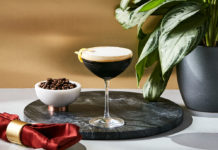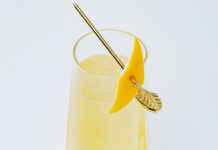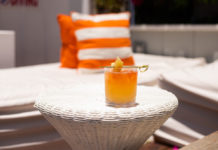 We all know music can transform the ambiance of a space, especially when we’re entertaining a crowd. The right tunes can instantly provide the perfect backdrop for a romantic date night, a lively happy hour, or a dance party for the ultimate night out. The ideal listening experience goes hand-in-hand with quality sound, which will keep guests happy and the drinks flowing into the wee hours of the night.
We all know music can transform the ambiance of a space, especially when we’re entertaining a crowd. The right tunes can instantly provide the perfect backdrop for a romantic date night, a lively happy hour, or a dance party for the ultimate night out. The ideal listening experience goes hand-in-hand with quality sound, which will keep guests happy and the drinks flowing into the wee hours of the night.
As temperatures rise, bars and restaurants are sweeping their patios and dusting off their outdoor speakers to allow patrons to get a dose of Vitamin D and fresh air. This spring and summer, make sure that your sound systems are properly equipped and ready to provide the ideal HD surround sound.
Shopping around for quality sound systems might sound daunting if you’re unfamiliar with audiophile jargon, but we’ve highlighted some commercial and hospitality sound equipment companies who shared best practices for choosing and setting up the right sound system.
“I would definitely suggest consulting with a professional,” advises Karl Kieschlich, National System Design Specialist of Sound Stage Systems, “to know what speaker to use, how to power it properly, how to process it so you get the right sound quality element and protection out of it.”
Sound Stage Systems is a 37-year-old national sound, lighting, and video design installation contracting company specializing in indoor and outdoor sound equipment, video systems, and entertainment lighting.
When setting up your sound equipment outdoors, Kieschlich recommends speakers that meet at least an IP65 or IP67 rating to withstand the elements of Mother Nature. The IP, or “Ingress Protection” rating, determines the level of protection against the intrusion of environmental factors such as dust, debris, liquid, and other foreign objects that may interfere with the sound.
The first numeric digit represents the degree of protection against solid; the second digit against liquid. According to the IP rating chart, an IP code of IP67 will provide maximum, complete protection against dust and between 15 centimeters and one meter in depth against water immersion.
Among the plethora of speaker models you can choose from, Kieschlich recommends brands such as JBL or Electro-voice for quality outdoor speakers that span a variety of styles.
“To build up the full system, you’ll need amplifiers and a processor,” says Bradley Drummond, Global Market Manager of Nightlife at HARMAN. HARMAN is the leading manufacturer of professional audio, video, lighting, and control systems of high-fidelity brands, including the aforementioned JBL, AKG, Harman Kardon, Infinity, Lexicon, Mark Levinson, and Revel. “Choosing an amplifier is best done after you’ve chosen your speakers. You’ll need to get a certain power or output to achieve the full output of the speakers and get the ESPL (equivalent sound pressure level) that they’re desiring for that application. The same with the processor.
“Once you know how many zones you need and how many outputs, then you can pick the right amount of processors to handle the whole system. So we have a lot of systems to hit many different price points and power outputs.”
There are design elements that should be taken into consideration when choosing the right speaker. “If it’s outdoors, if you’re oceanfront, there’s the saltwater corrosion, which is a big element in beachfront properties,” says Kieschlich. “The dispersion of the speaker, which is the coverage pattern, that [also] has to be taken into consideration because sound outside travels.”
“You want [the equipment] to be weatherized,” says Jak Daragjati, owner of JD Systems, which has been providing sound and video system engineering, design consultations, design/build services, sales, rental, and audiovisual systems installation for more than
10 years. “If you have something that’s weather-resistant (not to be confused with waterproof), you’re gonna want it to be under an overhang.”
Daragjati recommends Community Professional Loudspeakers, a brand
that designs premium performance speakers with a series of models meant for extreme weather environments. Although there are different levels of coverage, Daragjati admits that nothing is “100% foolproof.”
Drummond mentions that HARMAN’s models don’t require significant protection when not in use. “The stuff we have, even at the smaller ratings, can still handle a good amount of water. But obviously the higher you go the more protected it will be,” he says. “If you’re going to install some things under an awning but still outdoors, you can get away with some of the lower IP54-rated products. If it’s going to be out in direct sunlight and rain, you probably want to go with something closer to an IP56.”
Weather conditions aside, customers will benefit from a versatile and enjoyable listening atmosphere if bar owners decide to invest in a quality sound system.
If you run an establishment where
you opt for softer, brunch-friendly vibes
but shift to a livelier scene toward the evening, you’ll be pleased to learn that the transition is fairly simple. The speakers will remain the same. Just adjust the amplifiers and processing accordingly in order to boost the sound.
“It’s always easier to go bigger then lower than it is to go the other way around,” says Daragjati. “If you do need that capability of going higher and becoming loud later on and raising the decibel level, then you’re better off going with some heavier systems—going to a larger format box and just lowering it during the day. There’s no reason to purchase two different sets of equipment.”
“Typically, you want to design your system to be able to handle your loudest, worst-case scenario,” adds Drummond.
This means you want equipment that’s capable of reaching peak levels at night. You can set up a separate time preset to handle a louder volume. Feel free to also make adjustments to the high frequency or bass accordingly. “[With] a lot of our products, you can set up a schedule. Say at 6:00 it will automatically switch over to that preset. Or you can have it be a manual trigger on a button press or some kind of control page.”
Both Kieschlich and Daragjati say that multiple speakers throughout the venue will ensure a more even coverage versus blasting the volume from a single point.
“You might have 15, 20, 30 speakers throughout the venue,” says Kieschlich. “So when you’re in dinner mode, you’re not raising the volume to be able to hit all the tables—it’s an even volume throughout the space.
“The experience you’re giving to the customers should be from the front door to the back door.”
By Andria Park
All photos: JD Systems.








